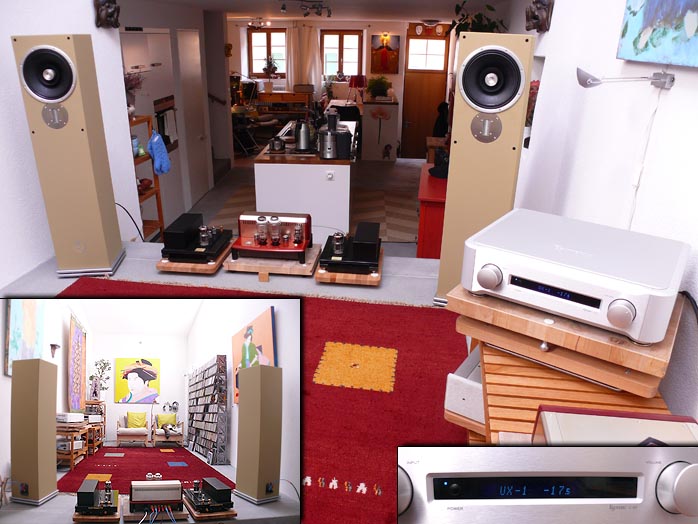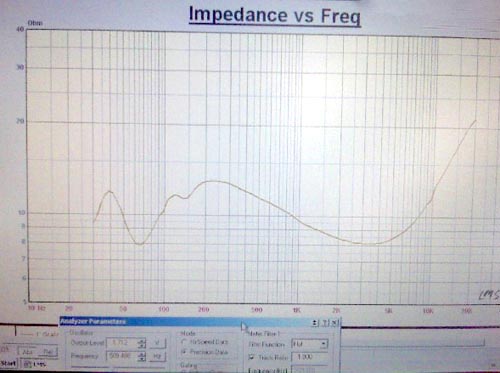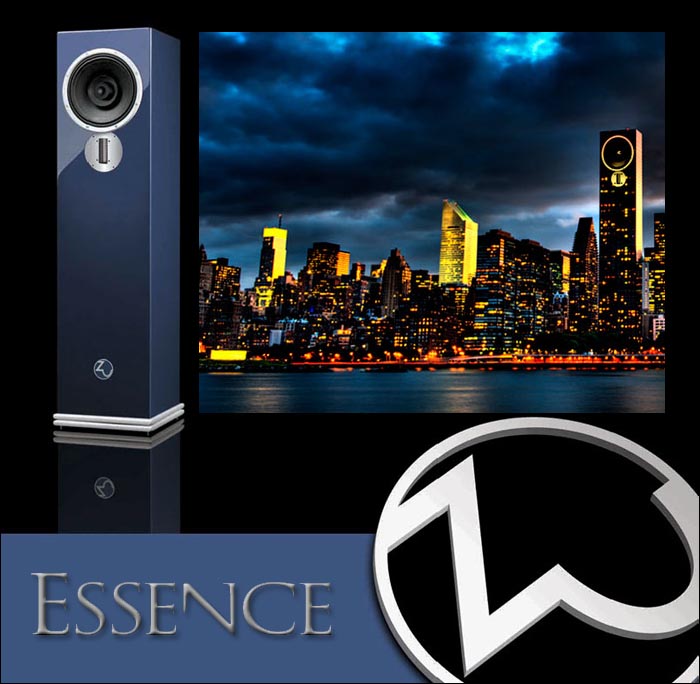|
This review page is supported in part by the sponsors whose ad banners are displayed below
|
|||||||||||||||
 |
|||||||||||||||
He was as lame as a duck. Not the metaphorical lame duck either but a real duck that was actually lame. Maybe from stepping on a land mine or something. Zu routinely gets flak for overstated sensitivities from the lame duck brigade. Those quackers never listen but argue endlessly: Impossible. Can't work. Cow dung. For a basic but practical test, I leashed up my 2wpc Yamamoto A-08S, switched the Esoteric C-03 preamp to zero gain and its display from 'step' to 'attenuation'. Instead of showing 0 to 99 where 99 screams, this shows attenuation in actual dB. Zero then means no cut or loudest and when configured for zero gain, unity gain or blunt source output. And fork a duckie, for my customary listening levels, the 45 triodes ran at about 17 to 20dB below unity gain (standard 2V source). Land mine alert. While this gets us no actual sensitivity figure in dB, we can securely pronounce Essence sensitivity adequate (or whatever else understated Britishers might call it). |
|||||||||||||||
 |
|||||||||||||||
His thoughts tumbled in his head making and breaking alliances like underpants in a dryer without Cling Free. As the photos show, my room isn't exactly puny. This only leaves 'wimpy levels' or 'New Age fluff' for the objectionists to cling to and explain without static how the Essence could work with the Yamamoto and a passive preamp. We'll merely add that when the Esoteric is set to 12dB of circuit gain, you wouldn't want to get near 0 regardless of what you play. Naturally, trip-hop rave fanatics wouldn't even know about the Yamamoto while those lusting after it will have different listening habits. Suffice it to say that shy of the last word in bass articulation which the lower output impedance and perhaps higher current delivery of my 25wpc FirstWatt F5 and 150wpc ModWright KWA-150 deliver, this combination became one of my favorites. |
|||||||||||||||
|
| |||||||||||||||
That's because for a SET, the A-08S is very lit up. It's fast without any tendencies to the voluptuous. Though passive when set to zero gain but running off 38-volt rails to be very dynamic, the Esoteric preamp did not dilute these qualities but rather enhanced them. As my comments of the previous page predicted, these qualities complemented the Essence voicing to a 't'. My 8wpc Yamamoto A-09S (300B) and the 18-watt Ancient Audio Single Six monos (6C33C) toned down a bit of the energetic excitement or blood-thinner effect of the Emission Labs 45s. |
|||||||||||||||
 |
|||||||||||||||
| The submitted impedance plot might help explain why such | |||||||||||||||
| low-power amps work well. In the critical bass frequencies, the lowest the impedance drops is to 8Ω at 70Hz. Below that it rises to 12Ω at 40Hz and drops down again to 9Ω at 30Hz. (This plot is of the pre-foam cartridge version which used strategically perforated cardboard filled with fiber.) The A-08S comments contradict those on the previous page as a signifier that between pre and final production versions, Zu had massaged performance into higher gear. Not sure they'd be willing to divulge all, I nonetheless dispatched an e-mail with the cryptic subject header "Fess up!" and questioned what all they had changed*. Simply put, now the Essence behaved like high-efficiency speakers again to support the persuasive low-level listening only such designs can. ____________________ *The changes made to the production version are a 2nd order Bessel-based high pass filter on the ribbon (10kHz mathematical, 12kHz acoustical), refining how the filter is attached and even higher tolerance matching due to larger production runs (1% on drivers, 0.1% on all other electrical components). With a large production run we're able to match to near crazy tolerances. Running lots of units all at once enforces efficient and accurate production methods so there were some improvements in the rebuilding of the widebanders over the earlier pair too. Here are all the final specs. She had a deep throaty genuine laugh like that sound a dog makes just before it throws up. This would apply only to those with fiercely held preconceptions born of snide supremacy - and just before they heard a pair of fully broken-in Essence. The appearance of Blumenhofer's €16,000 Big Fun 20 down-firing back horns with compression horn tweeters made that point. While the Essence inarguably injects warmth into the picture, it doesn't derive from time-based compromises. Hence it does not undermine the rhythmic boogie factor. This distinction must be understood. Thomas Blumenhofer's acoustic 3rd-order networks at 1.3kHz inject an audible blur by comparison. It dulls transients, washes out transitions and, most vitally, compromises momentum. Despite his tweeters' horn loading which to the general public might suggest speed and cutting power, the transient fidelity of the Essence is far more truthful. If that's what you key in on, the other speaker is irreparably flawed no matter what else it might do brilliantly. The hailstones leaped off the pavement like maggots frying in hot grease. Zu's unfair advantage is to wed such timing exactitude with high mass. Speakers with zing usually are lean. Think mini monitors with ribbons. We're unfamiliar with bruisers who are truly quick on their feet to deliver karate-like punches. The two seem mutually exclusive. The final Essence demonstrated the same heft or fisticuff displacement of the first pair but its reflexes were rather snappier. Whatever the exact reason, the $5,000/pr Essence was far more communicative and exciting than the thrice-priced German front/rear horn combo. That sounded comparably buttoned down and homogenized. Zu's rollick also included weightier, bouncier bass with superior self damping. |
|||||||||||||||
 |
|||||||||||||||
He was as tall as a 6'3" tree. As the previous page reminds, it always depends what something gets compared against. My French Tango R speakers have Zu's timing but greater harmonic resolution, even lower bass and, as a function of diminished tone density, even higher subjective speed. At €18,500, they are also significantly dearer. My $6,000/pr DeVore Fidelity Nines are significantly leaner in character and dynamically paler but their decay tracking and ambient recovery are better. During my Blumenhofer audition, I deliberately refused their smaller €5,000/pr Fun 17 model. It became obvious that the Essence would have eaten it for breakfast. I thus declined signing up for a predestined unfortunate outcome. It did however put into perspective just what the money buys you here. While on dollar signs, Gallo Acoustics' Reference 3.1 was shy of $3K when launched. As the Ref 3.5, it will re-launch at ca. $6,000/pr later this year. Green Mountain Audio's Pico was $5,000 when I first discussed a review. The surviving HD version is closer to $8,000. Both companies claim audible improvements. Fundamentally though, their price hikes absorb serious increases in parts and manufacturing costs. In fact, the model revisions are predicated upon those. The Druid Mk4 was $2,800 when it bowed. The Essence is essentially twice that. But it's significantly more than just a reissued Mk5 Druid. Considering how other companies react to the altered economic landscape of 2009, this pricing seems not at all out of line especially since it now includes dealers. When performance gets factored in, it's in fact very attractive. Shots rang out as shots are wont to. Stating the obvious isn't an art but gets to the point quickly. The Essence arrives at its performance not with parts density, apparent hi-tech cabinetry, fancy form factors or any of the usual bragging rights (except for the ribbon perhaps). Its rather simple recipe instead relies on very tight matching and extensive rebuilds of the few parts involved. That reductionist's optimization demands a certain maturity in both manufacturing and design processes. One simplifies and strips away until what remains is refined and pure. Simple really does it. |
|||||||||||||||
 |
The cleverest and likely most controversialist ingredient is the foam pyramid. It turns the speaker's exhaust into a form of horn (the sound waves travel its outside rather than inside as usual) before the small circumferential gap deliberately increases radiation resistance. This combination rear-horn slot loading not only downshifts the F3, it imparts audible damping. How and why is beyond my ken but the results with various tube amps from 2W 45s to 18W 6C33Cs left no doubt. Bass reach, weight and texture are very good and don't require brute force to shine. What's more, the bass gestalt is better integrated than the Hypex-powered Presence. Its nicely continuous with the midband. Titi Robin's Anita! [Naive] is the perfect showcase album to recapitulate Essence virtues. |
||||||||||||||
|
For more on this amazing artist, visit his website
|
|||||||||||||||
| The virile duel between Titi's oud and Ze Luis Nascimento's frame drum is an exercise in transient pepper and forceful bass impact as Ze really beats the crap out of his big skin. Recorded live, the electricity of the encounter must be palpable, tension high, various attacks flaring out like solar bursts. If your hairs don't stand up, it's all for nothing. Transmission of the encoded energy is key and deliverance rides on pure timing and heft. The Essence nails both. While more 'modern' leaner designs focus on greater apparent detail retrieval (see next paragraph), Zu shines a light on rhythm, coherence and mass. Those too are ingredients vital to the hi in fi but oft neglected. They are innate qualities of the recorded event but audiophiles invoking resolution never refer to these details. Are they chopped liver? Her face was a perfect oval like a circle whose two sides were gently compressed by a Thigh Master. If you ask what makes live sound obvious from behind a barely cracked-open window where soundstaging, timbre, separation and even frequency response are skewed like that hilarious exercise circle, you'll probably find that it's timing, dynamics and tone density which automate our recognition of real sound. If so, those particular aspects of the playback performance are senior in import to the rest that fill audiophile check lists ad infinitum. This gets us to an inevitable while sobering conclusion: the Zu Essence gets squarely right what many far more expensive speakers fail to even consider. That the €220 Dayens Ampino integrated from Serbia drives the proverbial piss out of it merely is the cherry on top. The young fighter had a hungry look, the kind you get from not eating for a while. Back in the cosmetic two-tone business, Zu's look is attractively modern, customizable and now even includes wood veneers and aluminum perf grills. The new twin plinth takes the guess work out of the bass loading while the TangBand ribbon adds top-end sparkle without rewriting rules for extension or air. It's an evolutionary refinement rather than fundamental rethink. Thank the audio deities for that. Otherwise, Zu would have finally sold out and abandoned the faith. Not. Their anti-establishment stance is alive and well in the Essence sound while the company image now downplays some of it. As one grows and sobers up, that's only fitting. Be more of yourself but make less of a fuss. As the Ampino proved, the Essence really is a very unfussy operator. Being more finely balanced between expanded extension on either end, it's also rather more of a good thing that many listeners already enjoyed. And yes, it's a speaker with a lot of color. That also means the audio police would could it colored -- rightfully so in the bookish sense-- but compared to perfectly 'legit' aka linear and lean speakers, I'd be surprised if not far more people preferred them colors. |
|||||||||||||||
 |
|||||||||||||||
McBride fell 12 stories hitting the pavement like a Hefty bag filled with vegetable soup. With bigger speakers coming down Zu's new pike, I remain curious what kind of rooms those would want when the Essence already plays mine so well. This bears stressing. Going nearly as low as my reference speakers, the lighter bass weaponry of the Essence excites the room far less. No splatter if we stay with McBride. Even with Franck Tchang's personal resonator installation, his Tango R is so potent as to occasionally borderline on endowed recordings. The Essence doesn't trigger the same resonant hot spots in the room. It's thus a far more reasonable proposition, i.e. far less tweaky. Audiophile reviewers are expected to be tweaky. Yet growing older just like the Zu men implies the - um, occasional exhaustion with the nuttier aspects of the gig. When easy does it for real as it does here, it's one bloody relief. I'm perfectly serious. The ballerina rose gracefully en pointe and extended one slender leg behind her like a dog at a fire hydrant. For one kind of truthiness in this price class, I have the DeVore Fidelity Nines. For another, I now have the Essencias. I'm not sure how one pluralizes Essence but I don't live in a typical suburban neighborhood with picket fences that resemble Nancy Kerrigan's teeth. Remember Stereophile's most famous cover? If one of these is right, the other must be wrong. Thankfully, life isn't that simple or we'd all be bored stiff. One of the many things the Essence clearly is not is boring. I for one applaud this loudly. In fact, big sigh of relief. Over and out. |
|||||||||||||||
| Quality of packing: Very stout. Reusability of packing: Multiple times. Ease of unpacking/repacking: Easy. Condition of component received: Perfect. Completeness of delivery: Sharp spikes, dull spikes, contact cleaner, tack cloth. Warranty: 5 years. Website comments: Far more informative than before. Certain imagery still parlays a punkier image than matches the actual product. Human interactions: Prompt and forthcoming on all info requested. Pricing: Right on target and considering certain competitors, high value. Final comments & suggestions: Offer clear-anodized terminal plates for those who go with the equivalent trim ring, tweeter mount and phase plug. |
|||||||||||||||
|
| |||||||||||||||
 |
|||||||||||||||
|
Zu Audio website
|
|||||||||||||||
 |
|||||||||||||||